人教版高中英语教学设计0001
- 格式:docx
- 大小:11.80 KB
- 文档页数:4
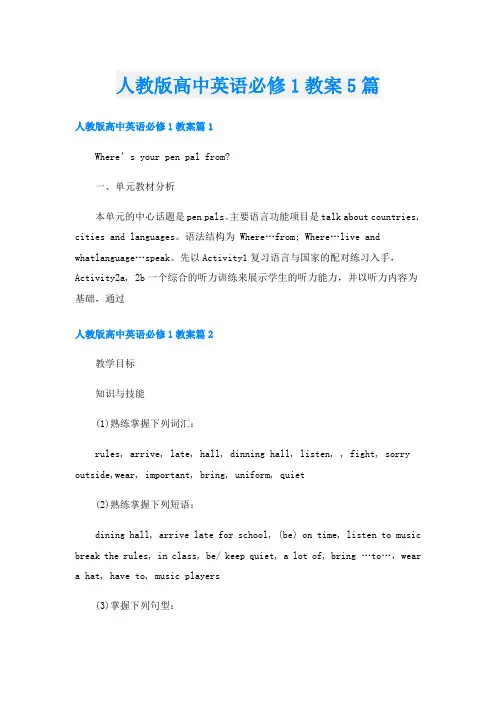
人教版高中英语必修1教案5篇人教版高中英语必修1教案篇1Where’s your pen pal from?一、单元教材分析本单元的中心话题是pen pals。
主要语言功能项目是talk about countries, cities and languages。
语法结构为 Where…from; Where…live and whatlanguage…speak。
先以Activity1复习语言与国家的配对练习入手,Activity2a, 2b一个综合的听力训练来展示学生的听力能力,并以听力内容为基础,通过人教版高中英语必修1教案篇2教学目标知识与技能(1)熟练掌握下列词汇:rules, arrive, late, hall, dinning hall, listen, , fight, sorry outside,wear, important, bring, uniform, quiet(2)熟练掌握下列短语:dining hall, arrive late for school, (be) on time, listen to music break the rules, in class, be/ keep quiet, a lot of, bring …to…,weara hat, have to, music players(3)掌握下列句型:1. Dont eat in class.2. You must be on time.3. Eat in the dining hall.4. 正确使用情态动词can, can’t——Can we wear a hat in school?——Yes, we can./No, we can’t.5. 能正确使用have to 和 must 谈论规章制度We must be on time/ We also have to be quiet in the library. 教学重难点重点:1) 肯定祈使句是省略掉主语的原形动词开头;2) 否定祈使句则是在肯定祈使句前加上“don’t”。
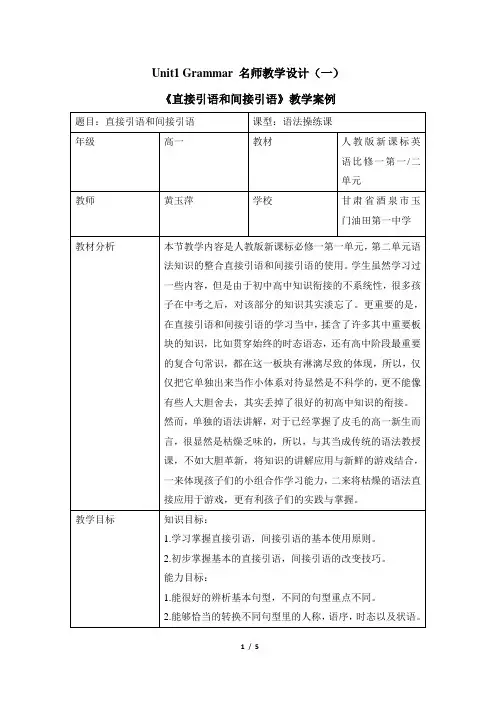
Unit1 Grammar 名师教学设计(一)《直接引语和间接引语》教学案例NEW SENIOR ENGLISH FOR CHINA STUDENT'S BOOK1UNIT1 FRIENDSHIP PRACTICE AND DRILLSBy Jennifer from Jiuquan, Gansu Province PART 1: SpeakingHow to express your ideas when you hare the same ideas with others?_____________________________________________________________________ If you have different ideas, what should you say?_____________________________________________________________________ PART 2:Functional Expressions:I am ____________,how about you?(自己也一样)_______________________________________________________ I am not ________,how about you?(自己也一样不)______________________________________________________ (注意观察老师上课讲到的其他句式,如何选自助动词,并为自己做好笔记,下课后总结)_____________________________________________________________________ _____________________________________________________________________ PART3:Grammar Skills:Step1.___________________ step2._______________________Step3.___________________ step4._______________________PART 4:Who Made The Gossip?1. Write down your sentence, and then change it into another form.(注意自己的句子:是直接引语还是间接引语?然后根据技巧变动句式,并总缩出自己的规律。
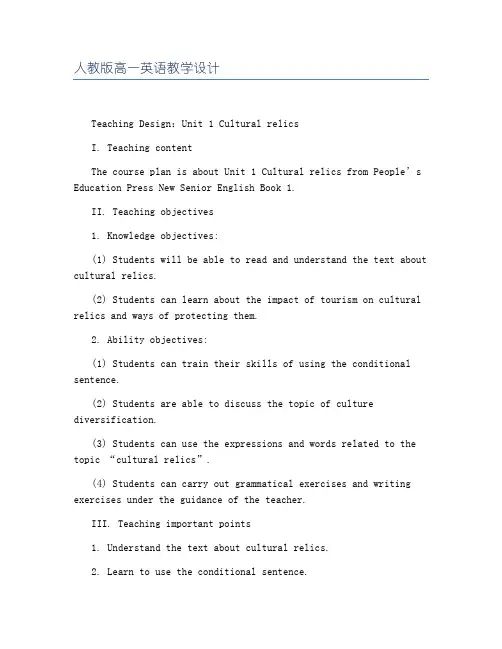
人教版高一英语教学设计Teaching Design:Unit 1 Cultural relicsI. Teaching contentThe course plan is about Unit 1 Cultural relics from People’s Education Press New Senior English Book 1.II. Teaching objectives1. Knowledge objectives:(1) Students will be able to read and understand the text about cultural relics.(2) Students can learn about the impact of tourism on cultural relics and ways of protecting them.2. Ability objectives:(1) Students can train their skills of using the conditional sentence.(2) Students are able to discuss the topic of culture diversification.(3) Students can use the expressions and words related to the topic “cultural relics”.(4) Students can carry out grammatical exercises and writing exercises under the guidance of the teacher.III. Teaching important points1. Understand the text about cultural relics.2. Learn to use the conditional sentence.3. Learn to use the relevant expressions and writing skills.IV. Teaching difficult points1.Master the usage of the conditional sentence.2.Know how to write with the relevant expressions and writing skills.V. Teaching methods(1) Task-based method;(2) Cooperative learning;(3) Discussions to explore.VI. Teaching aidsMultimedia,PPT and blackboard.VII. Teaching procedureStep 1 Lead-in(1) Let the students guess the title of the lesson.(2) Introduce the topic of this lesson and arouse the students’ interest by means of a short video clip and some questions.Step 2 Pre-readingHelp the students to preview the text by giving out some comprehension questions related to the theme of cultural relics.Step 3 While-reading(1) Have the students read the text.(2) Explain and learn the target language points related to the text.(3) Ask the students to do some exercises related to the text.Step 4 Post-readingGive out tasks for the students to do:(1) Imagination tasks.(2) Brainstorming tasks.Step 5 Sum upHelp the students review the knowledge they have learnt in this lesson.Step 6 HomeworkAsk students to search applicable news and write an essay based on the knowledge they have learnt.。
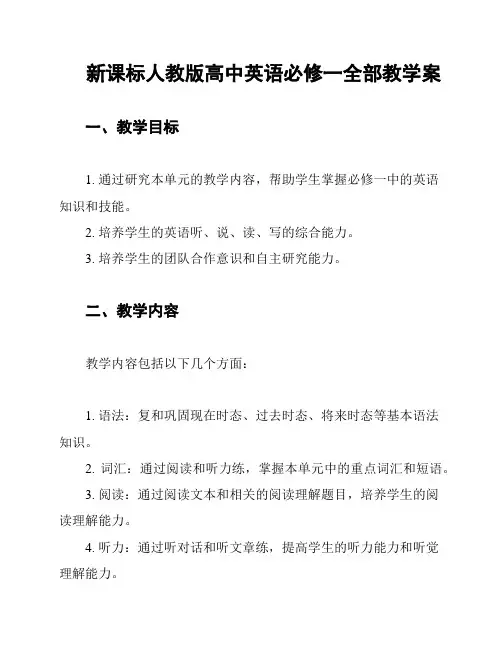
新课标人教版高中英语必修一全部教学案一、教学目标1. 通过研究本单元的教学内容,帮助学生掌握必修一中的英语知识和技能。
2. 培养学生的英语听、说、读、写的综合能力。
3. 培养学生的团队合作意识和自主研究能力。
二、教学内容教学内容包括以下几个方面:1. 语法:复和巩固现在时态、过去时态、将来时态等基本语法知识。
2. 词汇:通过阅读和听力练,掌握本单元中的重点词汇和短语。
3. 阅读:通过阅读文本和相关的阅读理解题目,培养学生的阅读理解能力。
4. 听力:通过听对话和听文章练,提高学生的听力能力和听觉理解能力。
5. 口语:通过各种口语练,提高学生的口语表达能力。
三、教学方法1. 任务型教学法:通过让学生完成一系列任务,激发学生的研究兴趣,加强学生的实际运用能力。
2. 合作研究法:引导学生在小组内进行合作研究,促进学生之间的互动和交流。
3. 归纳法:通过教师引导和学生参与,将教学内容进行总结和归纳,提高学生的研究效果。
四、教学步骤1. 导入:通过引入生活例子或相关资料,唤起学生对新学知识的兴趣。
2. 语法讲解:教师通过讲解和示范,介绍本单元的语法知识。
3. 词汇研究:通过词汇游戏和词汇练,帮助学生记忆和掌握本单元的重点词汇。
4. 阅读训练:教师通过指导学生阅读文本和做阅读理解题目,提高学生的阅读理解能力。
5. 听力训练:教师播放相关听力材料,学生进行听力训练和听觉理解练。
6. 口语练:教师引导学生进行口语练,提高学生的口语表达能力。
7. 总结归纳:教师对本节课的教学内容进行总结和归纳。
8. 作业布置:教师布置相应的作业,巩固学生对本节课的研究。
五、教学评价1. 教师根据学生的课堂表现、作业完成情况和考试成绩等,进行教学评价。
2. 学生之间进行互评,促进学生之间的交流和研究成长。
六、教学资源1. 教材:新课标人教版高中英语必修一教材。
2. 多媒体设备:投影仪、电脑、音响设备等。
3. 课外资料:相关的练册、参考书和教育软件等。
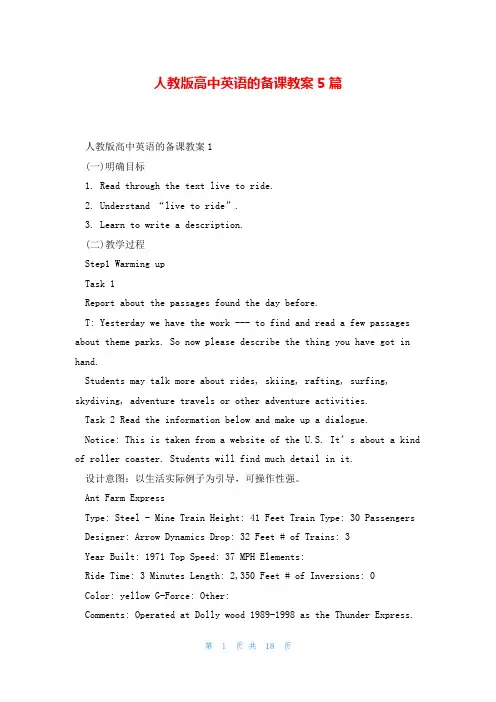
人教版高中英语的备课教案5篇人教版高中英语的备课教案1(一)明确目标1. Read through the text live to ride.2. Understand “live to ride”.3. Learn to write a description.(二)教学过程Step1 Warming upTask 1Report about the passages found the day before.T: Yesterday we have the work --- to find and read a few passages about theme parks. So now please describe the thing you have got in hand.Students may talk more about rides, skiing, rafting, surfing, skydiving, adventure travels or other adventure activities.Task 2 Read the information below and make up a dialogue.Notice: This is taken from a website of the U.S. It’s about a kind of roller coaster. Students will find much detail in it.设计意图:以生活实际例子为引导,可操作性强。
Ant Farm ExpressType: Steel - Mine Train Height: 41 Feet Train Type: 30 Passengers Designer: Arrow Dynamics Drop: 32 Feet # of Trains: 3Year Built: 1971 Top Speed: 37 MPH Elements:Ride Time: 3 Minutes Length: 2,350 Feet # of Inversions: 0Color: yellow G-Force: Other:Comments: Operated at Dolly wood 1989-1998 as the Thunder Express.Also operated as one of two mine train tracks called the River King Mine Train at Six Flags St. Louis from 1971 to 1988. Relocated herein 20__.Photos: ……Students may raise questions as follows:What’s the nameWhen was it builtHow many passengers can it take at a timeWhat is the lengthHow high can it goWhat about the top speedAre there any comments about it … …Step2 ReadingTask 1 SkimmingQuestion:What attraction can be found important in theme parks → Rides, the “thrill ride” …Task 2 ScanningQuestions:1. How do people ride roller coasters nowadays2. What is a thrill ride likeAnswers:1. Rides are wider and scarier than ever.The cars run faster, the tracks are higher, and people go through twists, loops, and drops. Some let people race against their friends. Some ride through darkness inside a mountain and a building.2. Very exciting and scary.Thrill rides use speed, motion, and special effects to give you aSome let you feel what it is like to fall through the air.Some rides send you through caves and even rivers.Thrill rides can also send you into space or deep down in the ocean.Task 3 DiscussingGroup Work Question: What else can we do in a thrill rideS1: We can dash through the snow during the ride.S2: We will ride together with some animals.S3: The car rides in a desert. … …Summary:We can imagine so man y ways, but it’s still not enough.The only limit to the fun is the imagination of the designers ofthe thrill rides. It seems to be endless.Quote: The great progress in science roots in completely new and brave imaginations of the human beings. ---- Dewey“科学的伟大进步源自于崭新与大胆的想象力。
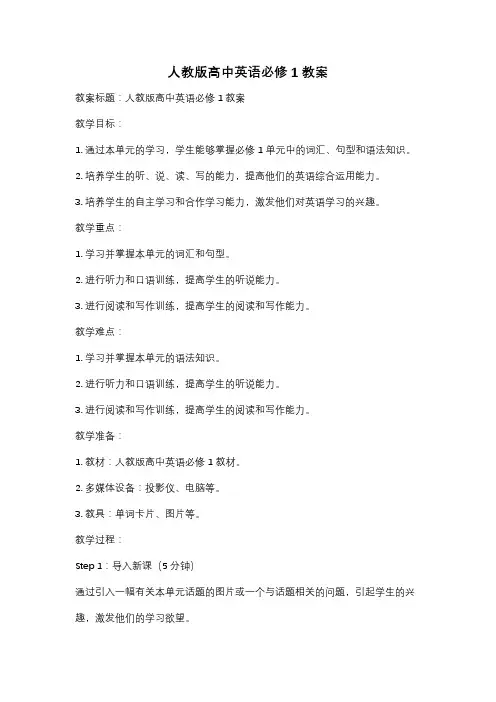
人教版高中英语必修1教案教案标题:人教版高中英语必修1教案教学目标:1. 通过本单元的学习,学生能够掌握必修1单元中的词汇、句型和语法知识。
2. 培养学生的听、说、读、写的能力,提高他们的英语综合运用能力。
3. 培养学生的自主学习和合作学习能力,激发他们对英语学习的兴趣。
教学重点:1. 学习并掌握本单元的词汇和句型。
2. 进行听力和口语训练,提高学生的听说能力。
3. 进行阅读和写作训练,提高学生的阅读和写作能力。
教学难点:1. 学习并掌握本单元的语法知识。
2. 进行听力和口语训练,提高学生的听说能力。
3. 进行阅读和写作训练,提高学生的阅读和写作能力。
教学准备:1. 教材:人教版高中英语必修1教材。
2. 多媒体设备:投影仪、电脑等。
3. 教具:单词卡片、图片等。
教学过程:Step 1:导入新课(5分钟)通过引入一幅有关本单元话题的图片或一个与话题相关的问题,引起学生的兴趣,激发他们的学习欲望。
Step 2:词汇和句型学习(15分钟)1. 呈现本单元的重点词汇和句型,通过图片、单词卡片等多种方式进行词汇和句型的学习。
2. 利用课堂互动,让学生进行词汇和句型的操练和运用。
Step 3:听力和口语训练(20分钟)1. 播放相关听力材料,要求学生仔细听,并回答相关问题。
2. 分组进行口语训练,让学生运用所学词汇和句型进行对话练习。
Step 4:阅读和写作训练(20分钟)1. 学生阅读本单元的相关文章,理解文章内容,并回答相关问题。
2. 学生根据所学内容,完成相关写作任务,如写一篇关于旅行的短文。
Step 5:语法知识学习(15分钟)1. 呈现本单元的语法知识,通过示例和练习的方式进行讲解。
2. 让学生进行语法知识的操练和运用。
Step 6:课堂小结和作业布置(5分钟)对本节课的学习内容进行小结,并布置相关的课后作业,如完成课后习题或写一篇关于旅行的短文。
教学反思:通过本节课的教学,学生能够在听、说、读、写各方面得到全面的训练,提高他们的英语综合运用能力。
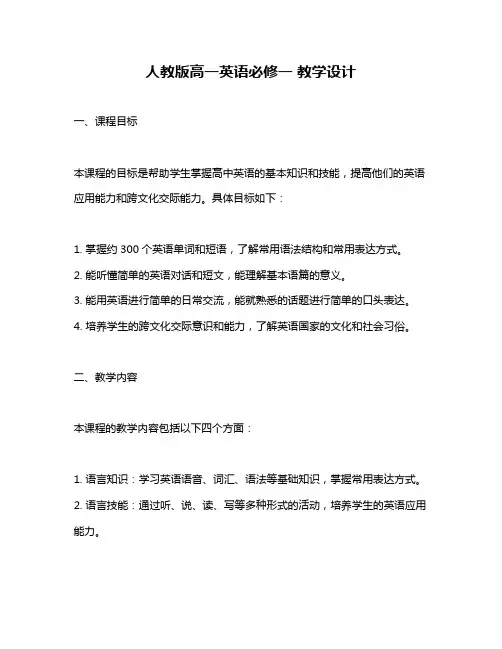
人教版高一英语必修一教学设计一、课程目标本课程的目标是帮助学生掌握高中英语的基本知识和技能,提高他们的英语应用能力和跨文化交际能力。
具体目标如下:1. 掌握约300个英语单词和短语,了解常用语法结构和常用表达方式。
2. 能听懂简单的英语对话和短文,能理解基本语篇的意义。
3. 能用英语进行简单的日常交流,能就熟悉的话题进行简单的口头表达。
4. 培养学生的跨文化交际意识和能力,了解英语国家的文化和社会习俗。
二、教学内容本课程的教学内容包括以下四个方面:1. 语言知识:学习英语语音、词汇、语法等基础知识,掌握常用表达方式。
2. 语言技能:通过听、说、读、写等多种形式的活动,培养学生的英语应用能力。
3. 跨文化交际:了解英语国家的文化和社会习俗,培养学生的跨文化交际意识和能力。
4. 学习策略:帮助学生掌握有效的学习方法和技巧,提高学习效率。
三、教学建议为确保教学效果,教师需要采取以下措施:1. 创造良好的语言环境:在课堂上尽可能使用英语进行教学和交流,营造良好的语言氛围。
2. 激发学生的学习兴趣:通过生动有趣的教学活动和多样化的教学手段,激发学生的学习兴趣和积极性。
3. 注重实践应用:在教学中注重学生的实践应用,通过对话、短文写作等方式提高学生的英语应用能力。
4. 培养学生的自主学习能力:引导学生自主学习,培养他们的独立思考和解决问题的能力。
5. 及时反馈和评价:对学生的表现及时给予反馈和评价,帮助他们发现问题并及时改进。
四、评价与反馈为了更好地评估学生的学习成果,需要制定评价标准和方法。
以下是一些建议:1. 平时成绩:根据学生的课堂表现、作业完成情况等平时成绩进行评价。
可以采用量化评价和质性评价相结合的方式。
2. 测验和考试:定期进行测验和考试,检查学生对所学知识的掌握情况。
考试形式可以多样化,如选择题、填空题、阅读理解等。
3. 口头表达:通过口头表达的形式,检查学生的口语表达能力。
可以安排学生分组进行对话练习或个人演讲等活动。
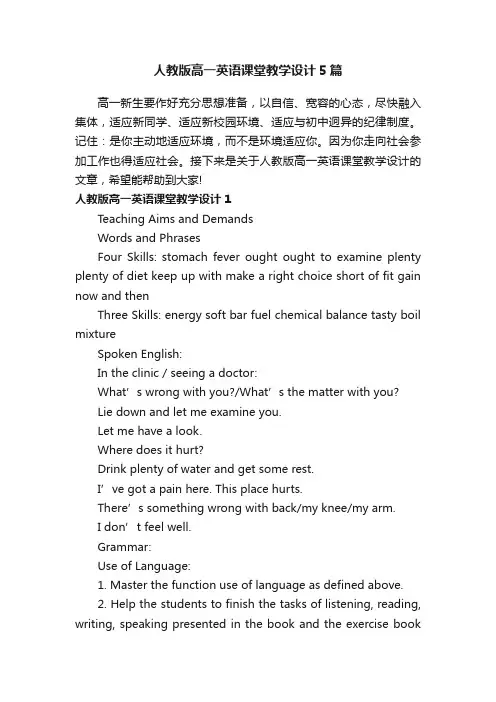
人教版高一英语课堂教学设计5篇高一新生要作好充分思想准备,以自信、宽容的心态,尽快融入集体,适应新同学、适应新校园环境、适应与初中迥异的纪律制度。
记住:是你主动地适应环境,而不是环境适应你。
因为你走向社会参加工作也得适应社会。
接下来是关于人教版高一英语课堂教学设计的文章,希望能帮助到大家!人教版高一英语课堂教学设计1Teaching Aims and DemandsWords and PhrasesFour Skills: stomach fever ought ought to examine plenty plenty of diet keep up with make a right choice short of fit gain now and thenThree Skills: energy soft bar fuel chemical balance tasty boil mixtureSpoken English:In the clinic / seeing a doctor:What’s wrong with you?/What’s the matter with you?Lie down and let me examine you.Let me have a look.Where does it hurt?Drink plenty of water and get some rest.I’ve got a pain here. This place hurts.There’s something wrong w ith back/my knee/my arm.I don’t feel well.Grammar:Use of Language:1. Master the function use of language as defined above.2. Help the students to finish the tasks of listening, reading, writing, speaking presented in the book and the exercise bookthrough using what the students have learned.Learn the text about healthy eating. Get the students know about the basic knowledge of how to eat healthily.Important points:1. Talk about different kinds of food that one favorites.2. learn the basic knowledge of healthy eating.3. learn how to say in the clinic.4. Grasp the language points and grammar in the text.Difficult points: The use of modal verbs --- had better, should and ought to.Teaching aids: computer or slider-projectorWay of Teaching: Communication way of teaching, discussion and group work.Lesson 1Step 1 Warming-UpFirst show the students some pictures of dishes and so to introduce the topic of this unit.And then show the pictures on their text books and let them to decide what is junk food and what is not.Here the students may have a short ask and answer in pairs to themselves more engaged in the topic.Step 2 ListeningLet the students listen to the tape and be prepared to answer the questions below.Step 3 SpeakingShow the students the three situations as on P2. Then ask the students to prepared a dialogue according to the examples in pairs. Ask several pairs of students to present their dialogue After that list the useful expressions in their dialogue.Step 4 HomeworkPrepare for the next class.Collect some menus if possible for the next class.Lesson 2Step 1 IntroductionUsing the questions on P3 to introduce the new text.Step 2 Fast-reading1.What does the “fuel ” mean in the first paragraph?(It means different kinds of materials, such as protein, Calcium that we need to keep healthy.)2.What do we have to consider when we choose to buy or eat?(What kinds of nutrients that the food contain.)3.What made our eating habit changing?(Many things: what people believe, advice from companies and stores.)4. How can we feel and look fine?(We ought to learn about our body and the fuel it needs to keep fit.)Explain the language points if necessary.Step 3 Carefully-readingHow many parts can be divided into?(Three parts.)What’s the main idea of each part?(1.our eating habits are changing. 2.why the eating habits are changing 3.the best way to develop healthy eating habits.) Step 4 TalkingAsk the students to take out their menus and read them carefully. Then prepare a dialogue that may happen between a customer and a waiter/waitress.Step 5 HomeworkFinish the exercise --- Vocabulary on P5. and P72-73Lesson 3Step 1 RevisionCheck the homework.Step 2 GrammarFirst present the students the modal sentences with Modal Verbs and ask the students to make some sentences with them.Step 3 Consolidation(1) Finish the exercise on P5 and on P74(2)Take out a piece of paper with the column “Ask ###” in order to make the students understand when you are giving advice it is better to use some sentences with had better (not), and ought(not) to, should(not). Then read a passage as an example and afterwards list the points you have to pay attention to when you give advice.1.give advice that will really help the person.2. be polite and sincereat last get the students to finish the following practice.Step 4 HomeworkFinish the exercise 3 on P74 in the students’ workbook.Lesson 4Step 1 RevisionLet some students read their reply to the letters on P74.Step 2 ReadingRead the text on P6 and then get the students to find the main idea of it (Snacks is also important . we need to learn something about snacks and the way to prepare it.)Step 3 WritingAsk the students to work in pairs to write the recipe for their favourite dish.We may first give the tips on P7 as a guide.Step 4 DiscussionFirst ask the students to read the passage on P75 and then give the following questions as the topic for the students to talk: What is a couch potato?What does one have to pay special attention to in order to keep healthy? (food and exercise etc.)Step 5 HomeworkDo a general survey in order to learn about the differences between people’s eating habits and try to find which is healthier.人教版高一英语课堂教学设计2Teaching aims and demands:a. Achieve language skills and related knowledge about the topic of friends and friendship;b. Learn to express likes and dislikes and make apologies:c. Vocabulary in this unit:the words and expressions listed on the teacher’s bookd. Grammar:Direct and indirect speechLesson 1Step 1 Presentation and discussion (warm-up)Put some new words on the blackboard and tell them something about a friend.Kind honest brave loyal happy wise strongbeautiful handsome rich smart funnyThen ask some questions around the class and discuss with them.What should a good friend be like?What qualities should a good friend have?Should they be funny, smart and strong?Step 2 ReadingAsk the students to read the dialogue in the part SPEAKING. Ask some questions:1.What doesn’t John like?2.What does Joe think of music and skiing?And then fill in the form on page 3.Then ask the students to express their ideas freely. Encourage the students to say more about friends.Step 3ListeningAsk the students to listen to the tape and fill in the blanks in the listening part.Step 4 Talking/PracticeAsk the students to page 85. Make a similar dialogue as in exercise 2.Some useful expressions :Why did you…? Why didn’t you…? You said that you would…Please forgive me. You promised to … I’m very sorry… It won’t ha ppen again. I forgot.Step 5 HomeworkFinish Exercise 3 in the workbook.Lesson2Step1 RevisionAsk several students to present a speech about friends as a revision.Step 2 Pre-readingPresent the students a picture to illustrate the situation on a lonely island. Ask them to list three items in the box and ask them to give the reasons using the sentences listed on page3.Step 3 ReadingBefore asking the students to read the text, first give the students a brief introduction about Tom Hanks, his films and the film Cast Away.Then students read the text, and answer the following questions.1.How does Chuck Noland come to a deserted island?2. In order to survive on the island alone, what does he need to learn?3. What does he understand at last?4. For us, what lesson we can learn from Chuck?At the same time explain the language points if necessary.Step 4 Post-readingDiscuss the following questions in the Part POST-READING.Step 5 HomeworkPrepare a talk about Tom Hanks or something about one of his film.Lesson3Step 1 RevisionGet the students to give a talk about Tom Hanks or something about one of his films.Step 2 Language StudyAsk the students fill in the blanks with proper words.Step 3 GrammarIllustrate to the students the use of Direct and Indirect Speech.Then ask the students to do the exercise in the Part Grammar on P5.Step 4 PracticeAsk the students to act the exercise2 in the part Grammar out.Step 5 HomeworkAsk the students to finish the exercise2 in their workbook.Lesson4Step 1 RevisionCheck the homework.Step 2 PresentationPresent simples of e-mail to get the students a general idea of e-mail.Step 3 ExplanationTell the students some tips of writing an e-mail by learn the above e-mail simple.Step 4 WritingAsk the students to write an e-mail message.Step 5 HomeworkAsk the students to try to write an e-mail to their e-pal.人教版高一英语课堂教学设计3Ⅰ. Teaching Basis (教学依据) :《普通高中英语新课程标准》Ⅱ. The Type of the Text (课型) :Revision (复习课)Ⅲ. Teaching Methods(教学方法): Question-based method(提问式),Group discussionmethod(小组讨论法),Cooperative learning(合作探究),Practicing(练习).Ⅳ. Teaching Aids (教学手段) :Multimedia computer(多媒体电脑),Learningpaper(导学案),Blackboard(黑板).Ⅴ. Teaching Aims(教学目标) :①Knowledge aims(知识目标): words: achievement, specialist, organization, hard-working, confident….. phrases: put to death, mean doing, either…or…, the bond between……, structure: only+…., It is/was+….+that…. grammar: Subject-verb agreement.②Ability aims(能力目标): Develop the students’ ability to use the importantlanguage points, enable students to describe people using the adjectives.③Emotional aims(情感目标): Encourage the students to think about what makes aperson great.Ⅵ. Teaching focuses(教学重点):Get the students to review and consolidate what theyhave learned in this unit.Ⅶ. Teaching difficulties(教学难点):Get the students to turn what they have learned intotheir ability.Ⅷ.Teaching procedure(教学过程): Step 1 复习学案情况反馈(1分钟)Step 2 lead-in :通过图片展示的方式,过渡到知识竞答类节目《一站到底》,本节课也将模仿这种模式授课。
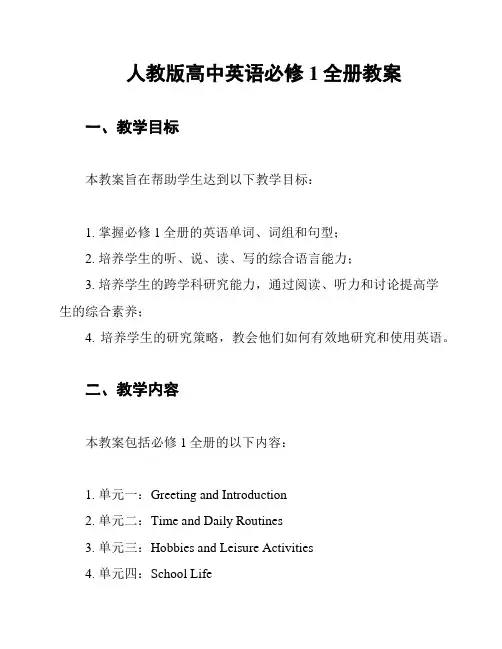
人教版高中英语必修1全册教案一、教学目标本教案旨在帮助学生达到以下教学目标:1. 掌握必修1全册的英语单词、词组和句型;2. 培养学生的听、说、读、写的综合语言能力;3. 培养学生的跨学科研究能力,通过阅读、听力和讨论提高学生的综合素养;4. 培养学生的研究策略,教会他们如何有效地研究和使用英语。
二、教学内容本教案包括必修1全册的以下内容:1. 单元一:Greeting and Introduction2. 单元二:Time and Daily Routines3. 单元三:Hobbies and Leisure Activities4. 单元四:School Life5. 单元五:Family and Relationships6. 单元六:Travel and Holidays每个单元的教学内容包括听、说、读、写的综合练,以及文化背景和研究策略的介绍。
三、教学方法本教案采用以下教学方法:1. 任务型教学:通过给学生一些具体任务,培养他们自主研究和合作研究的能力;2. 情境教学:将研究内容置于真实的生活情境中,帮助学生理解和使用英语;3. 多媒体教学:结合多媒体资源,提供丰富的听力、口语和阅读材料,激发学生的研究兴趣;4. 提问引导:通过提问引导学生思考和表达,激发他们的研究动力;5. 小组合作:鼓励学生进行小组讨论、合作研究,提高他们的沟通和合作能力。
四、教学评估本教案将通过以下方式进行教学评估:1. 课堂表现:观察学生在课堂上的参与程度、口语表达能力等;2. 书面作业:布置书面作业,检查学生对教学内容的理解和掌握程度;3. 小组项目:布置小组项目,评估学生的合作能力和综合运用能力;4. 课堂测验:定期进行课堂测验,测试学生的听力、阅读和写作能力。
五、教学资源本教案所需的教学资源包括:1. 教科书:人教版高中英语必修1全册;2. 多媒体资源:包括录音、视频和网络资源;3. 手机、平板电脑等电子设备:用于学生查阅和使用研究资源。
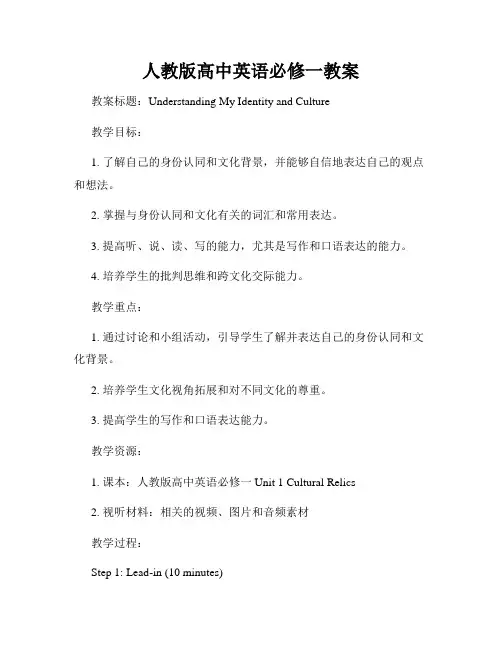
人教版高中英语必修一教案教案标题:Understanding My Identity and Culture教学目标:1. 了解自己的身份认同和文化背景,并能够自信地表达自己的观点和想法。
2. 掌握与身份认同和文化有关的词汇和常用表达。
3. 提高听、说、读、写的能力,尤其是写作和口语表达的能力。
4. 培养学生的批判思维和跨文化交际能力。
教学重点:1. 通过讨论和小组活动,引导学生了解并表达自己的身份认同和文化背景。
2. 培养学生文化视角拓展和对不同文化的尊重。
3. 提高学生的写作和口语表达能力。
教学资源:1. 课本:人教版高中英语必修一 Unit 1 Cultural Relics2. 视听材料:相关的视频、图片和音频素材教学过程:Step 1: Lead-in (10 minutes)1. Show a picture or short video clip related to cultural heritage or identity, and ask students to brainstorm what they see and feel about it.2. Facilitate a class discussion on the importance of cultural identity and heritage, encouraging students to share their own experiences and viewpoints.Step 2: Vocabulary and Language Input (15 minutes)1. Introduce and explain key vocabulary related to cultural identity, such as heritage, tradition, customs, etc.2. Provide examples and context for the vocabulary usage through a short reading or video clip.3. Engage students in a vocabulary activity, such as matching words with their definitions or completing sentences with the correct vocabulary words.Step 3: Reading and Comprehension (20 minutes)1. In pairs or small groups, have students read the assigned text from the textbook about cultural relics and answer comprehension questions.2. Discuss the answers as a class, fostering critical thinking and analysis of the text.3. Encourage students to share their thoughts on how their own culture and identity relate to the concept of cultural relics.Step 4: Discussion and Speaking Practice (15 minutes)1. Divide the class into small groups and give each group a topic related to cultural identity, such as "How does your cultural background shape youridentity?" or "What are the challenges and benefits of a multicultural society?"2. In their groups, students discuss the topic and come up with ideas and arguments.3. Each group presents their ideas to the whole class and engages in a discussion, respecting different opinions and cultural perspectives.Step 5: Writing Task (20 minutes)1. Assign a writing task that requires students to reflect on their own cultural identity and heritage.2. Provide a writing prompt, such as "Write a personal essay discussing the influence of your cultural background on your life and values."3. Allow students time to plan, draft, and revise their essays, and provide feedback on their writing.Step 6: Homework (5 minutes)Assign students to research and prepare a short presentation on a cultural relic or tradition from a different country or community.教学评估:1. 观察学生在讨论和小组活动中的参与度和思考深度,评估他们对身份认同和文化背景的理解。
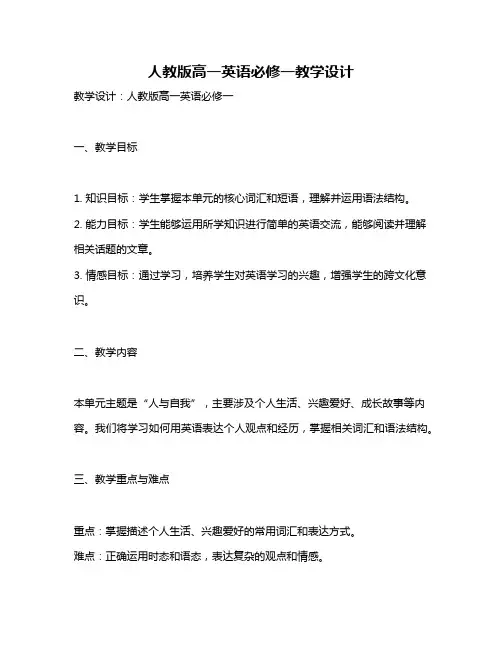
人教版高一英语必修一教学设计
教学设计:人教版高一英语必修一
一、教学目标
1. 知识目标:学生掌握本单元的核心词汇和短语,理解并运用语法结构。
2. 能力目标:学生能够运用所学知识进行简单的英语交流,能够阅读并理解相关话题的文章。
3. 情感目标:通过学习,培养学生对英语学习的兴趣,增强学生的跨文化意识。
二、教学内容
本单元主题是“人与自我”,主要涉及个人生活、兴趣爱好、成长故事等内容。
我们将学习如何用英语表达个人观点和经历,掌握相关词汇和语法结构。
三、教学重点与难点
重点:掌握描述个人生活、兴趣爱好的常用词汇和表达方式。
难点:正确运用时态和语态,表达复杂的观点和情感。
四、教学步骤
1. 导入(5分钟)
通过提问学生日常生活、兴趣爱好等话题,引导学生进入本单元主题。
2. 新课学习(30分钟)
通过讲解、示范、小组讨论等方式,学习本单元的词汇、语法和表达方式。
3. 练习与巩固(20分钟)
通过小组活动、角色扮演等形式,让学生在实际语境中运用所学知识,巩固所学内容。
4. 总结与反馈(10分钟)
对本节课所学内容进行总结,同时收集学生的反馈意见,以便改进教学方法。
五、教学评价与反思
通过观察学生在课堂上的表现,评估学生对本单元内容的掌握情况。
同时,反思自己的教学方法和效果,不断完善和提高教学质量。
新人教版高中英语必修一教学设计一、教学任务及对象1、教学任务本次教学任务是基于新人教版高中英语必修一的内容进行设计。
本教材以提升学生的英语综合运用能力为主要目标,围绕不同的主题,培养学生听、说、读、写四项基本技能。
在教学过程中,我将重点关注学生对英语语法、词汇、句型的掌握,以及在实际语境中运用英语进行交流的能力。
此外,通过丰富多样的教学活动,激发学生的学习兴趣,使他们形成良好的学习习惯,为今后的英语学习打下坚实基础。
2、教学对象本次教学设计的对象为高中一年级学生。
他们已经在初中阶段学习了英语基础知识,具备一定的英语听说读写能力。
然而,由于学生的英语水平参差不齐,教学中需要充分考虑个体差异,因材施教。
此外,高中阶段的学生正处于青春期,具有强烈的求知欲和好奇心,但同时也可能存在一定的叛逆心理。
因此,在教学中,教师需要关注学生的心理变化,采用适当的教学策略,调动他们的学习积极性,引导他们形成正确的价值观。
二、教学目标1、知识与技能(1)掌握新人教版高中英语必修一的全部词汇、短语和基本句型,能熟练运用所学知识进行日常交流;(2)提高学生的英语阅读能力,能够理解并分析文章的主旨、大意、细节和结构,提高阅读速度;(3)培养学生英语写作能力,能够根据给定的话题进行有逻辑、有条理的写作;(4)提高学生的英语听力水平,能够理解并掌握教材中听力材料的要点,并能进行简单的口头复述;(5)通过口语表达训练,使学生能够自信、流畅地运用英语进行口头表达,增强英语实际运用能力。
2、过程与方法(1)采用任务型教学法,设计丰富多样的教学活动,让学生在实践中学习英语;(2)运用合作学习法,鼓励学生之间相互交流、讨论,共同解决问题,提高学生的团队协作能力;(3)采用启发式教学法,引导学生主动思考,培养学生的自主学习能力和探究精神;(4)注重个体差异,因材施教,针对不同水平的学生制定合适的学习任务和目标;(5)运用多媒体教学手段,创设生动、直观的英语学习情境,激发学生的学习兴趣。
人教版高中英语教学设计一、教学任务及对象1、教学任务本教学设计针对的是人教版高中英语课程,主要围绕英语语言知识、语言技能、学习策略和文化意识等方面进行教学。
通过本设计,旨在帮助学生掌握英语语法、词汇、发音等基本知识,提高学生的听、说、读、写四项基本技能,培养学生自主、合作、探究的学习方法,增强跨文化交际意识和能力。
2、教学对象本教学设计的对象为高中阶段的学生,他们已经具备一定的英语基础,能够进行简单的日常交流,但对于英语语法、词汇及文化背景等方面的知识掌握还不够深入。
此外,高中阶段的学生正处于青春期,具有较强的求知欲、表现欲和自我意识,因此,在教学过程中需要关注学生的个体差异,激发他们的学习兴趣,培养良好的学习习惯和态度。
二、教学目标1、知识与技能(1)掌握英语语法、词汇、发音等基本知识,能够运用所学知识进行日常交流;(2)提高学生的听、说、读、写四项基本技能,特别是提高阅读理解能力和写作表达能力;(3)熟悉英语国家的基本文化背景,了解中外文化差异,增强跨文化交际能力;(4)学会使用英语词典、网络资源等工具,拓展英语学习渠道,提高自学能力。
2、过程与方法(1)采用任务型教学法,让学生在完成具体任务的过程中,运用所学知识,提高语言实际运用能力;(2)运用合作学习、探究学习等方法,培养学生自主、合作、探究的学习习惯,提高学习效率;(3)采用多元化教学手段,如多媒体、网络资源等,丰富教学形式,激发学生的学习兴趣;(4)注重课堂互动,鼓励学生提问、发表观点,培养思辨能力和创新精神;(5)实施个性化教学,关注学生的个体差异,提供针对性的指导,使每个学生都能得到提高。
3、情感,态度与价值观(1)培养学生对英语学习的兴趣和热情,使其形成积极主动的学习态度;(2)引导学生树立正确的世界观、人生观和价值观,认识到学习英语的重要性;(3)培养跨文化意识,尊重和理解不同文化背景下的行为习惯和价值观;(4)培养学生具有良好的团队合作精神,学会与他人沟通、协作,共同解决问题;(5)注重德育教育,培养学生具有良好的道德品质和人文素养,成为有责任感、有担当的社会主义建设者和接班人。
知识目标:使学生了解并掌握一些新的词汇和有用的句型结构:重点词汇与短语greet prediction represent curious curiously approach cheek defend m ajor misunderstanding dash adult spoken likely crossroads defendagainst be likely to in generall 重点句子结构与用法Yesterday, another student and I, representing our university’s student association, went to …After half an hour of waiting for their flight to arrive, I saw several young people enter the waiting area looking around curiously.I stood for a minute watching them and then went to greet them.She stepped back appearing surprised and put up her hands, as if in defence.Then Akira Nagata from Japan came in smiling,together with Japanese student.语言技能目标:了解有关身势语的含义,并能根据要求描述和表达来猜出不同的身势语;能了解身势语的不同文化内涵并能正确地加以运用;能在阅读中通过语境识别新学词汇短语并推断其意思,能读懂课文摘录要点,能缩写本模块内容,能熟练地掌握主谓一致的用法情感目标:帮助学生了解文化差异和身势语的变化,防止跨文化交际中产生误解和冲突热身运动快速阅读细读有用的单词和短语向学生展示一些图片并要求他们描述必要时给予指导学生积极地讨论并描述图片完成表格并归纳段落大意进一步了解一些具体的细节并能做出正确的判断激发学生了解身势语的兴趣促使学生进行思考,培养其概括能力使学生了解不同文化背景下身势语的不同含义训练学生应用语言的能力。
高中英语教学设计高中英语人教版教学设计(精选11篇)作为一名专为他人授业解惑的人民教师,通常需要准备好一份教学设计,教学设计一般包括教学目标、教学重难点、教学方法、教学步骤与时间分配等环节。
怎样写教学设计才更能起到其作用呢?以下是店铺整理的高中英语人教版教学设计,仅供参考,希望能够帮助到大家。
高中英语教学设计篇1教学目标Wordsbase, command, request, recognizeExpressionsbecause of, come up, at present, make use of, such as, play a part (in)Patterns…because of that, English began to b spoken in many other countries.Actually all languages change and develop…The latter gave a separate identity to American English spelling.教学重难点■ To help students get to know about English development ■ To help students better understand “learning English”■ To help students understand and use some important words and expressions■ To help students identify examples of Indirect Speech (II): request & commands in the text教学工具课件教学过程⑴Warming up by listingGood morning, class. We have been learning English for several years. But how many English-speaking countries are there in the world? Now let’s ma ke a list of them on the blackboard.English Countries ExplanationMother tongue the United Kingdomthe United States of AmericaCanadaAustraliaSouth AfricaIrelandNew Zealand The people in these countries are native speakers of English. In total, for more than 375 million people English is their mother tongue.Second language IndiaPakistanNigeriathe Philippines These people speak the language of their own country at home but the language of the government, schools, newspapers, and TV is English.Foreign language ChinaGermanyFranceetc. The number of people who learn English as a foreign language is more than 750 million.⑵Warming up by answering questions about EnglishGood morning, class. Today we shall start learning Unit 2 English around the world. But how much do you know about English?●What is Standard English?Standard English is the form of English that most people in Britain use, and that is not limited to one area or group of people.●What is a dialect?A dialect is a variety of a language spoken only in one area, in which words, or grammar are slightly different from other forms of the same language.●Do we have standard Chinese? What is it?In China there’re so many dialects that the government encourages the whole nation to speak Putonghua, which is regarded as standard Chinese.⑶Warming up by giving reasonsUnit 2 English around the world is what we are going to learn today. We are all learning English now because English is so popular in the world. But do you know why it is so? How many reasons could you giving for the spread of English around the world?x English is one of the official languages of the Olympic Games and the United Nations.x English dominates international websites and provides nearly all of the new computer terminology.x Tourism and trade from Western Europe and North America has contributed to the spread of English.x Satellite TV, radio programs like Joy FM, CDs and, of course, Hollywood films all broadcast English into China. Also, a number of Chinese films include English subtitles.2.Pre-readingWe are learning English here. But why are we learning it? Could you suggest to the class as many reasons as you can think of, why people in the world learn English?for work, as a hobby, to learn about other people, to travel, to read literature in the original, to read research papers, to meet foreigners, to surf the Internet, to pass exams, etc.Go on with your reasons. I shall write your suggestions on the board as you make them.3. Skimming the text for general ideasNow we go to page 9 to skim the text for the main idea of each paragraph.Paragraph 1: The spread of the English language in the world Paragraph 2: Native speaker can understand each other even if they don’t speak the same kind of English.Paragraph 3: English changes and develops when cultures meet and communicate with each other.Paragraph 4: By the 19th century English is settled.Paragraph 5: English is spoken as a foreign language or second language in South Asia.4. Reading and fillingRead the text to complete the chart below.Time English is influenced by…AD 450-1150 German1150-1500 FrenchIn the 1600’s Shakespeare, who make use of a wider vocabulary than ever beforeBy the 19th century Samuel Johnson, Noah WebsterNow Languages in South Asia, in Singapore, in Malaysia, in Africa and in China5. Reading and copyingNext we shall go over the text once more. This time try find and copy all the useful expressions down in your notebook.Useful expressionsat the end of…, make voyages, speak English as…, in the next century, change over time, communicate with…, be based on…, at present, become less like…, rule England, enrich the English language, make use of…, move to…, later in the 18th century, give a separate identity to…, have a very large number of…, fluent English speakers, become the language for…, develop one’s own identity, increase rapidly高中英语教学设计篇2教学目标:1.To have a good review of the key words and phrases and be able to write the good and bad things about computers .2.To learn by ourselves and cooperate with each other.3.To be a hard-working,and practical student.教学重难点1.To have a good review of the key words and phrases and be able to write the good and bad things about computers .2.To learn by ourselves and cooperate with each other.3.To be a hard-working,and practical student.教学过程一.必考单词速记1.事实n. ________________2. (电脑)操作员,接线员__________3.性格;特点______________4.科技;工艺_______________5.目标,目的n. ______________6.出现;发生vi. ______________7.解决;解答vt. _______________8.类型,打字v.& n.____________9.发信号vi.& n ;信号._________10.无论如何,即使如此adv. ______二.写出下列单词的变化形式1. operator n.操作员;接线员→_____________v.操作;经营→____________n.操作;经营2. technology n.工艺;科技;技术→_______________ adj.科技的3. intelligence n.智力;聪明;智能→_________adj.智能的;聪明的4. appearance n.外观;外貌;出现→________________vi.出现5. application n.应用;用途;申请→_______________v.应用;申请→___________n.申请人;求职者6. explore vt.& vi.探索;探测→___________n.探险家;勘探者→_____________ n.探索7. personal adj.私人的;个人的;→________adv.就个人而言;亲自→_________n. 个性;人格;三、用所给词的适当形式填空(1)Can you say dolphins are much more ____________than other animals?Well, they are animals of high _____________. (intelligent)(2) She expressed her _________ opinion yesterday. ____________ speaking, I agreed with what she said. (personal)(3) Any ___________ who would like to _____________ to become anassistant in our company should send us an ___________ .(apply)四、语境助记——词不离句,句不离段With the electronic technology revolution going on,simplified calculation is solved in the application on finance by universal exploration. Our goal of making life happier is certain to be realized through man's intelligence.五、翻译下列必背短语?1.在某种程度上_______________2.依…看;据…认为_____________3.从…时候起_______________4.结果_______________5.处理;安排;对付____________6.弥补,补足;整理,编造_________7.毕竟_______________?8.看守,监视_______________9.在……帮助下_______________?六.根据句子意思写出单词的正确形式。
人教高中英语教学设计一、教学目标本次教学旨在通过激发学生的学习兴趣,培养他们的英语听、说、读、写能力,提高学生的综合语言运用能力。
具体目标包括:1. 掌握本单元的核心词汇和短语;2. 理解并运用本单元的重点句型;3. 能够就某个话题进行自由交流,并表达自己的观点和意见;4. 培养学生的阅读理解能力,能够正确回答与文章内容相关的问题。
二、教学重点1. 单词和短语的掌握;2. 听力和口语的训练;3. 高考阅读理解题型的训练。
三、教学准备1. 教材:人教版高中英语教材(高二上册);2. 多媒体设备;3. 听力材料;4. 课件。
四、教学过程步骤一:导入新课(15分钟)1. 利用多媒体设备播放一段关于话题内容的视频,引起学生的兴趣;2. 引导学生对视频内容进行简单的讨论,帮助他们了解本单元的主题和相关词汇。
步骤二:词汇学习(20分钟)1. 带领学生一起学习本单元的核心词汇和短语,通过图片、反义词、同义词等方式巩固记忆;2. 以小组形式进行合作记忆,利用闪卡进行热身复习。
步骤三:听力训练(25分钟)1. 通过播放听力材料,提高学生的听力理解能力;2. 引导学生自主听录音,回答与录音内容相关的问题;3. 分组进行听力对话训练,巩固学生的听力技能。
步骤四:口语训练(30分钟)1. 利用课件展示话题,组织学生进行小组讨论,鼓励他们用英语表达自己的观点和意见;2. 指导学生运用本单元的重点句型进行口语表达练习;3. 鼓励学生进行角色扮演,模拟真实场景下的英语对话。
步骤五:阅读理解训练(25分钟)1. 带领学生一起阅读教材中的阅读材料,引导学生掌握阅读技巧;2. 组织学生进行小组讨论,共同解决相关问题,提高学生的分析和解读能力;3. 提供高考阅读理解题型的练习,帮助学生熟悉考试题型,提高答题技巧。
步骤六:总结归纳(15分钟)1. 回顾本节课的教学内容和学习方法;2. 检查学生对本单元重点知识的掌握情况,进行评价;3. 鼓励学生总结学习经验,提出问题,进行互动交流。
人教版高中英语教学设计人教版高中英语必修 5 Unit 2 The United Kingdom一、教学内容分析:人教版新课标高中英语必修5第二单元(The Uni ted Kin gdom ) Usi ng Ian guageSightseei ng in London让学生了解英国首都伦敦的名胜古迹(BigBen;StPaul ' sCathedral ;WestminsterAbbey;Greenwich;Highgate Cemetery)二、教学目标(Teaching goals)1. 目标语言(Target Languagea. 重点词汇和短语sightsee ing, available, delight, tower, royal, uniform, sple ndid, statue, com muni sm, thrillb. 重点句式Worried about the time available, Zhang Pin gyu had ... P14What in terested her most was the Ion gitude lin e.P14It seemed stra nge that the man who had developed com munism should have lived and died in London. P14But she was thrilled by ... P142. 能力目标(Ability goals)Improve the read ing ability of the stude nts and en able the stude nts to pla n a tour around certa in places.3. 学能目标Learning ability goalsHelp the students know more about the historical sites in London.三、教学重难点(Teaching important & difficult points )Help the students identify different kinds of tour and talk about the most interesting place for the tour and master the key words and expressi ons in the passage.四、教学方法(Teaching methods )1、任务型教学法(Task-based teaching method。
读之前,教师设定阅读任务,学生在阅读过程中思考,分析,讨论,最终解决问题。
最后通过任务的完成而实现对所学知识的意义建构。
2、交际法教学:让学生在完成任务的活动中提高听说能力3、多媒体辅助教学法。
把有关英国的文本,图片等信息融合在课件中,发挥学生的多种感官作用,激发学生学习兴趣,提高学习效率。
在Reading部分对TheUK有了一定的了解,在此基础上进一步学习关于英国的一些名胜古迹。
五、教具准备(Teaching aids)A computer and a projector.六、教学过程与方式(Teachi ng procedures & ways)Step I Revisi on and Lead-i nTalk about London with the stude nts.T: London has been a capital city for nearly 1,000 years, and many of its ancient buildings still stand. Have you found any information about London?S1: The most famous sites in London are the Tower of London, Westmi nster Abbey and St. Paul ' s Cathedral. But most visitors also want to see the House of Pnt;liame Buck in gham Palace, which is the Quee n ' s London home.S2: On ce, London was a small Roma n tow n on the n orth bank of the Thames, but slowly it grew into one of the world ' s major cities with more than 7 million people.Different areas of London seem to be like different cities. And it also has many big parks, full of trees, flowers and grass. Sitting on the grass in the middle of Hyde Park or Kensington Garde ns, you are in the coun try, miles away.S3: Many people think that London is all gray, but in fact led is London ' s favorite color. London is at its best when people are celebrating. Then the flags, the cheering crowds and the carriages and horses all sparkle in the sun shine if it ' s not raining, of course! However, it is often foggy. That ' s why it ' s called “ fog city ”.Ask the stude nts to read the passage and do the exercises after the passage.T: “ Sightsee ing in London ” is about a Chin ese girl ' s first visit to London .It tells us how it would feel to visit London for the first time. Now read and find the answers to the questi ons after the text.Step n Read ingTask 1: Ask the stude nts to read the text to get the main idea.T: Now please read the text and find the answers to the following questions.Show the questio ns on the scree n.1. How did Zhang Pin gyu pla n her tour?2. What were the build ings men ti oned in the text? What were they famous for? Who built them? What happe ned to them?Sample an swers:1. First, she made a list of the sites she wan ted to see. The n she pla ned her four-day trip.2. The build ings men ti oned in the text were:Tower, built by Norman invaders of AD 1066, it is a solid, stone, square tower which remained standing for one thousand years; St Paul ' s Cathedral, built after the terrible fire of London in 1666, looked splendid; Westminster Abbey, contains statues in memory of dead poets and writers; Greenwich, the Iongitude line; Big Ben; Highgate Cemetery; Win dsor Castle. Task 2: Ask the stude nts to study the structure of the text “ Sightsee ing in London1. The Tower of London2. St Paul ' s Cathedral3. Westmi nster Abbey4. Big Ben5. Buck in gham PalaceShow the followi ng.(说明:教师可以借助图片评说、文化背景介绍和生活体验等方法导入,激活学生相关的知识网络,使学生产生阅读欲望。
)Gree nwichThe second day The third day The first day1. High gate Cemetery2. The Library of theBritish Museum3. Win dsor CastleTask 3 .Ask the stude nts find out the key words and expressi ons.(1) delight n.& vt.to one ' s delight = to the delight of sb.take delight inwith /in delightbe delighted at /by /withbe delighted to do sth .delightful adj.(2) rema in vi & lin ki ng vrema in --- remai ning (adj ) --- remai ns (n )After the fire ,very little remained of my house .剩下Much work remained to be done 有待以后再做I ' ll remained to see the end of the gamerIn fact ,the work rema ined unfini shed 仍然是The childre n rema ined liste ning .The In dia n people rema in in deep poverty .The rema ins of the ancient temple are worth see ing .残余物(3) thrill vt. & n.be thrilled at /with sththrilli ng adj.(4) Worried about the time available, Zhang Pingyu had made a list of the sites she wan ted to see in London.过去分词做原因状语=Because she was worried about(5) It looked sple ndid whe n first built .时间状语从句的省略=(when it was first built)(6) It seemed strange that the man who had developed communism should have lived and died in London. It作形式主语,that引导主语从句。